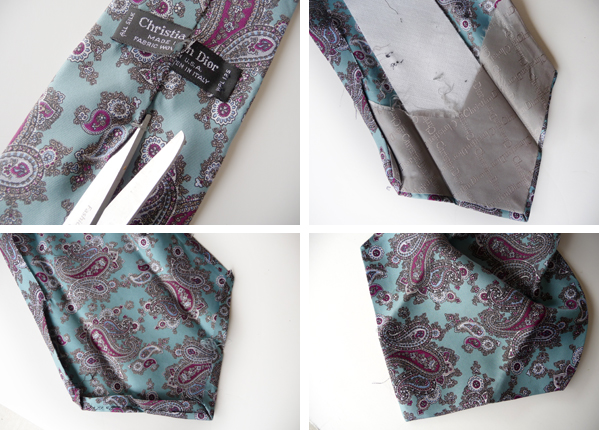SILK-DYED EGGS (aka TIE-Dyed!)
POSTED IN EASTER, HOLIDAY CRAFTS, SARA
03.23.2012
I posted this tutorial a few years ago and it has become somewhat of a tradition to bring it back every year! One of our family Easter traditions is dying eggs with pieces of silk. I saw a cute lady show Martha how to do it a few years ago and I ran upstairs right then to steal a tie! It’s way cooler than those cups of neon liquid that end up all over your clothes, your furniture and your hands plus it gives you an excuse to rid a man’s closet of ugly ties.
Here’s the run-down:
You need 100% silk for this to work. Make sure to check the labels to make sure you’re not buying polyester, which can look similar. I grab old ties at the thrift store where they’reusually pretty cheap. And remember: when it comes to ties, you may not want ugly ones on your man, but ugly ties do make pretty eggs! You could also use silk from an old blouse, a scarf, or whatever. So if you’re rummaging through a thrift store, check out some other areas as well.
I try to find an assortment of colors and patterns. Usually dark blues, purples, and reds work the best, but it’s fun to experiment with all kinds of things. The interesting thing is that you never know how much of the color and pattern will transfer to the eggs. Sometimes ties I think will be awesome really disappoint, and ones I didn’t think much of make the most beautiful eggs. Here’s some of the ties I grabbed from my local thrift store:
Usually it will tell you if it’s 100% silk right on the main label of the tie, but a lot of them don’t, and if that’s the case, check that little tiny end, it’s usually hiding there.
The first step is to deconstruct the tie. Snip the seams and remove the lining so you are just left with the silk. (And yes, this old Christian Dior tie, which I love, was only 50 cents at the thrift store! If it was a skirt, I would totally wear it. I have gotten many angry comments about the fact that I destroyed a Christian Dior tie. Honestly, for 50 cents I really don’t care who’s name is on it. Get over it, people!)
Next you cut a piece large enough to cover an egg. Wrap the egg with the right side of the fabric making contact with the egg. The right side is the printed side, or the side that would be on the outside of the tie. You want to try to wrap the fabric as tight as you can without breaking the egg of course. The more direct contact the silk has with the egg shell the clearer the imprint of the pattern. Where there are folds in the fabric you’ll get kind of a swirly water color effect. I love those parts- it adds to the charm. Once wrapped, tie with a piece of string or a twisty tie. (Do yourself a favor and go with the twisty tie!)
Now, notice how I tied the eggs in the above photo- with the tie on the top of the long side of the egg. If you do this, the opposite end of the egg will have the best pattern. If you are going to be sitting the eggs upright in an egg cup, this is the best way to wrap them.
However, if you want the best part of the design on the wide side of the egg, you’ll want to wrap them horizontally, like this:
Just wrap them as smoothly and tightly as you can for the best transfer.
I wish eggs came like this at the grocery store. I would probably buy a lot more eggs if they were dressed up in their silky best.
After the eggs are wrapped in silk, you’re going to wrap them again with a light colored light weight piece of fabric. An old pillowcase, sheet, or thin dish cloth is perfect. If you go to the thrift store to get ties, you may want to grab a pillowcase too. Otherwise you might get impatient at home and just take one from your kid’s room. Don’t tell my husband I did that.
Put all those little guys in a pot and cover them with water. Add 1/4 C vinegar and bring it to a boil. After about 20 minutes you can remove the eggs and set them in a colander or on a towel to dry and cool. Once they’re cool enough to handle you can remove the fabric.
This is my favorite part. I get so antsy waiting for them to cool. It’s always a surprise to see what went on in that little package.
Below are some of my results. I have to say that the first one is probably my favorite egg of all the ones I’ve ever done. I can’t believe how clearly those flowers transferred and how bold the colors turned out. Incredible!
Here are some older photos, but still fun to look at. I absolutely love the cool stripy, swirly thing going on in this one
This is one of the disappointments I talked about. I was so excited for a green tie and I thought the pattern was cool (ya know, for an egg) but it turned out super light and muted. Still pretty though, kind of like water colors.
I almost didn’t buy this blue tie because it looked boring, but I’m glad I did. Remember: bad ties make good eggs!
Try this out and let me know how it goes. Everyone will wonder how on earth you did it! Just tell them you’re a genius. Or give them our website. Your choice.
Here you can see the opposite sides of where I tied the silk, they get kind of a swirly watercolor look:
And here are the sides where the silk made the most contact:
If you want to add a little shine, just put a little vegetable oil on a paper down and give them a lig
Silk Dyed Easter Eggs
from ourbestbites.com
Cut pieces of 100% silk large enough to cover an egg. Wrap as smoothy and tightly around egg as possible, with right side of fabric facing in, and secure with a twist-tie or piece of string. Repeat process, but wrap with a plain piece of lightweight fabric, like an old white pillowcase or sheet.
Place eggs in a large stock pot and cover with water at least 2 inches above eggs. Add 1/4 cup white vinegar. Bring pan to a boil and reduce to simmer. Simmer for 20 minutes and then use a pair of tongs to remove eggs and lay them (still wrapped) on layers of paper towels or an old dish towel. Let cool to room temperature and then remove the fabric wrappings. Store in the fridge until ready to display. If desired, rub with a small amount of vegetable oil for shine.
To complete this process with blown-out eggs, click here.





















